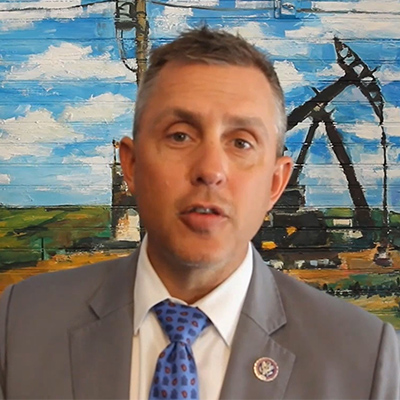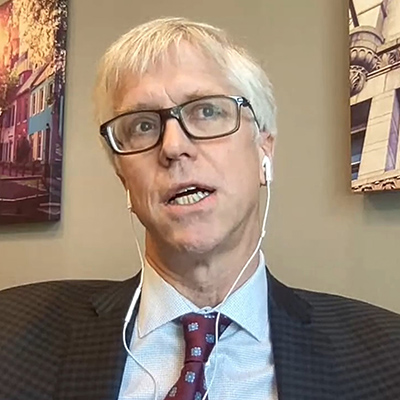
Conservatives’ vision for a clean energy future includes contributions from natural gas, nuclear and hydrogen; domestic mineral mining; and fewer regulatory hurdles, according to speakers in the online National Clean Energy Week Policy Symposium this week.
At times, politicians’ views contrasted with the industry experts invited to speak at the symposium.
 Rep. Kelly Armstrong (R-N.D.) | National Clean Energy Week
Rep. Kelly Armstrong (R-N.D.) | National Clean Energy Week
Appearing onscreen in front of a painting of an oil well, U.S. Rep. Kelly Armstrong (R-N.D.) said he hoped that conversations on energy production in an era of climate change continue to be “based on reality and not ideology.”
Armstrong said Europe’s continuing energy crisis shows the importance of U.S. energy independence. He said the U.S. should expand its natural gas infrastructure and shouldn’t be “demonized” for its fracking.
In his message, House Minority Leader Kevin McCarthy (R-Calif.) presented an alternate narrative to the one offered by many Democrats and said fossil fuels play an important part in it.
“While Democrats wage a war on our oil and gas producers, we know that America’s a leader in reducing emissions, and that natural gas we produce here at home is cleaner than Russian natural gas,” he said during a Tuesday keynote. “We know the importance of investing in domestic energy and mineral production to maintain energy security and protect our supply chain from China.”
McCarthy thanked Citizens for Responsible Energy Solutions (CRES) for its advocacy.
“House Republicans prioritize comprehensive permitting reform and elimination of regulations on energy and infrastructure costs that delay projects and increase costs,” he said. “We look forward to partnering with you to achieve these goals.”
Rep. Debbie Lesko (R-Ariz.) said Europe’s and California’s recent energy hardships show that “rush-to-green-energy policies” fail citizens. She said the U.S.’ clean energy future should include the reliable output that nuclear energy and clean hydrogen can supply, and that Congress should focus on “responsible, clean, all-of-the-above” energy policies.
Rep. Cathy McMorris Rodgers (R-Wash.), a previous CRES Clean Energy Champion, spoke of improving and retaining the power-generation technology now in use, including nuclear, hydro and natural gas. She spoke of cleaner energy but did not mention climate change, a primary factor driving the push for clean energy.
“This week, Republicans on [the House Energy and Commerce Committee] are celebrating how America has led the world in reducing carbon emissions and promoting innovation by utilizing America’s abundant, clean, affordable and reliable energy,” she said. “Our framework, the Securing Cleaner American Energy Agenda, builds on this legacy to lower energy costs and make our infrastructure and electricity grid more resilient. It includes solutions to unleash innovation for cleaner natural gas, emissions-free hydropower and nuclear power, and carbon-capture technology.”
By contrast, McMorris Rodgers said, the “rush to green” pressed by Democrats will force the energy transition on families and industry, spiking costs, undermining national security and stifling innovation as a result.
“Republicans support a level playing field and a balanced mix of energy resources. As we add more weather-dependent renewables like wind and solar, we must maintain our most reliable baseload power sources,” she said.
Utility executives echoed a need for hydrogen and nuclear output.
Lauren Sher, NextEra Energy’s director of sustainability and environmental policy, said to achieve a steady, 24/7 decarbonized energy supply, utilities will need to rely on zero-emissions fuels like green hydrogen to operate existing generating facilities.
American Public Power Association CEO Joy Ditto said to accomplish big decarbonization goals, her public power producers are enthusiastic about small modular reactors.
“I know you all in California might not want to talk about nuclear, but elsewhere in the country, we really are extremely bullish on smaller modular reactors [and] more affordable nuclear as we move forward, particularly for smaller communities,” Ditto said.
Streamlining Permitting
Panelists agreed that the country’s permitting processes are unwieldy, unnecessarily long and in need of streamlining to keep pace with a necessary transition.
Xan Fishman, the Bipartisan Policy Center’s director of energy policy and carbon management, said on its face, clean energy funding through the Infrastructure Investment and Jobs Act and Inflation Reduction Act (IRA) should be enough to jumpstart an energy transition in earnest.
“We’ve got money for innovation; we’ve got money for deployment. It would seem like our clean energy future is right at our fingertips,” Fishman said.
However, Fishman quoted the Aspen Institute’s 2021 “Building Cleaner, Faster” report, which focused on the problem that “achieving net-zero emissions by 2050 is ecologically essential, technologically feasible, economically achievable, but procedurally impossible” given the current permitting environment.
 Johnson Controls’ Katie McGinty | National Clean Energy Week
Johnson Controls’ Katie McGinty | National Clean Energy Week
“I wish it were only a bumper sticker. It has the unfortunate characteristic, I think, of being absolutely true,” Johnson Controls’ Katie McGinty said of the problem statement. “The status quo is not solving climate. We have to deliver more environmental protection. Mother Nature is shaking her fist. … Some red tape needs to get cut.”
McGinty invoked the 2,000-plus renewable generation projects in PJM’s interconnection queue that have little chance of coming online quickly because she said the grid remains unprepared.
U.S. Sen. Dan Sullivan (R-Alaska), whom CRES announced as one of its 2022 Clean Energy Champions just a day earlier, said the environmental regulations created a half-century ago have morphed into something untenable.
“When the National Environmental Policy Act came out in the late ’60s, it was a really good bill,” Sullivan said. “What’s happened unfortunately is that NEPA has been fully 100% abused, and it’s grown into a law that courts and far-left radical environmental groups use to block essentially everything.”
Sullivan spoke of a gold mine in Alaska that needed 20 years to obtain a permit and said the highway leading to the mine took 30 years to permit.
“This is an issue — permitting reform; the abuse of NEPA — that literally hurts every single American; whether you want to build a wind turbine, or a solar panel, or a highway project, or an airport runway, or a gold mine, or an oil and gas development, it blocks everything,” he said. “We as a country, I believe, are finally starting to wake up to this issue that has bedeviled my state for decades, and we’re starting to take action.”
Despite this, Jeremy Woodrum, senior director of congressional affairs for the Solar Energy Industries Association (SEIA), predicted U.S. solar panel manufacturing will soon pick up with “at least” 20 to 25 GW worth of domestic solar panel manufacturing capability. He said SEIA’s goal is to have 50 GW of annual solar energy manufacturing capacity by 2030, two and a half times the total solar capacity installed last year in the U.S.
“We’re looking to go big, and folks who go first are going to reap the rewards,” Woodrum said.
Critical Minerals
Experts agreed that the U.S. must quickly scale up a critical minerals industry and reinforce a supply chain to source a clean energy future.
ClearPath Senior Director Alex Fitzsimmons said critical minerals like nickel, cobalt, lithium and graphite are the “lynchpin” of decarbonized energy production.
 Nano One CEO Dan Blondal | National Clean Energy Week
Nano One CEO Dan Blondal | National Clean Energy Week
“I think to truly build a domestic supply chain for critical minerals, we need to marshal all the resources we have now in law and policy to three primary goals,” he said, explaining that the U.S. must invest in upstream mining and processing capabilities, invest in recycling facilities and invest in mineral substitutes.
“We have a wall of demand coming for raw material supplies, mining [and] refining, and everything has to happen long before you assemble a battery,” Nano One Materials CEO Dan Blondal agreed.
Blondal predicted central Canada will become a “center of gravity” for battery materials in the North American market. The IRA “put EV tax credits on the line” by mandating that batteries be assembled with environmentally friendly and responsibly sourced materials. He said automakers scrambled to find replacements for Chinese-made batteries to handle near-term demand without jeopardizing tax credit eligibility.



